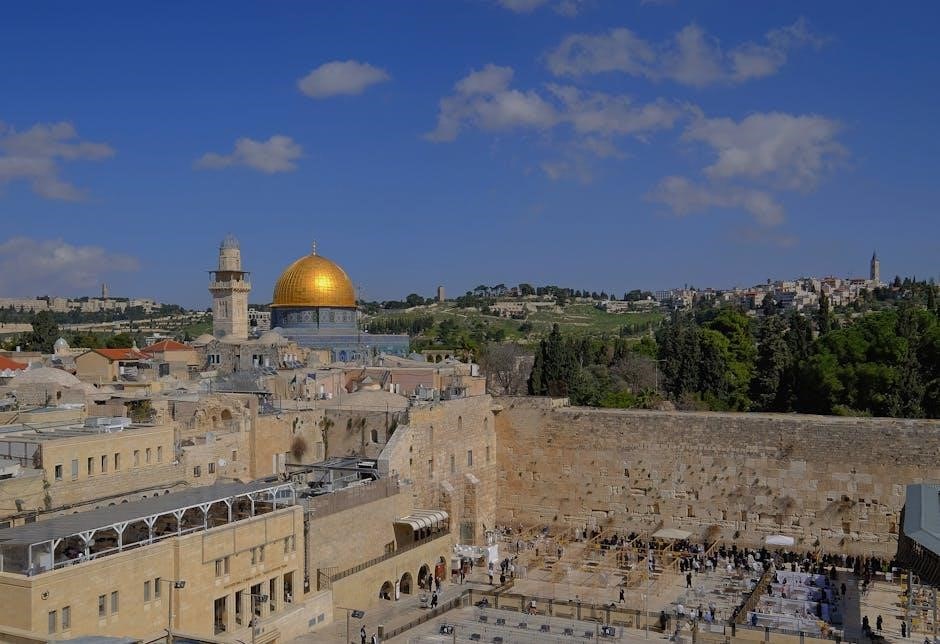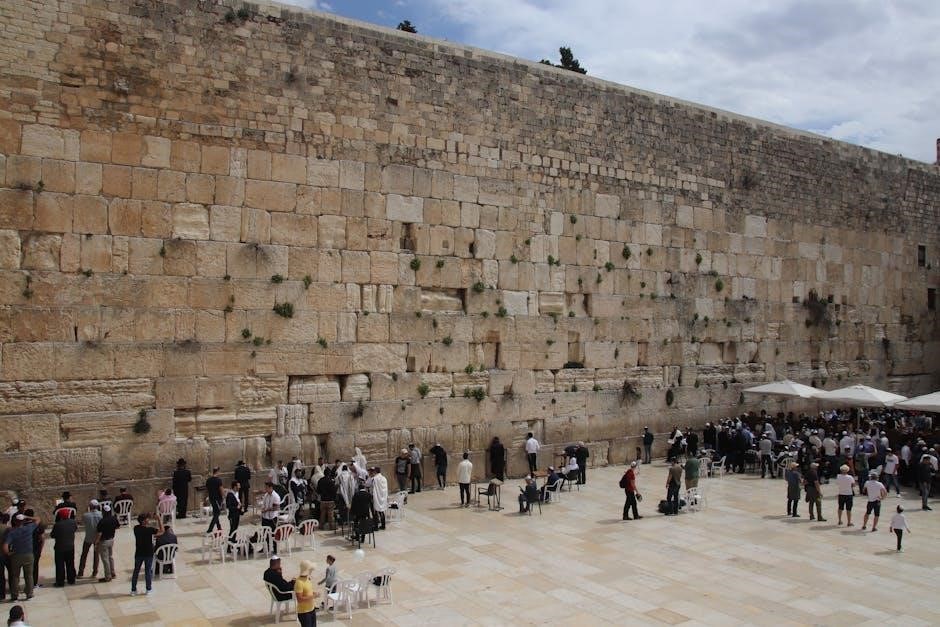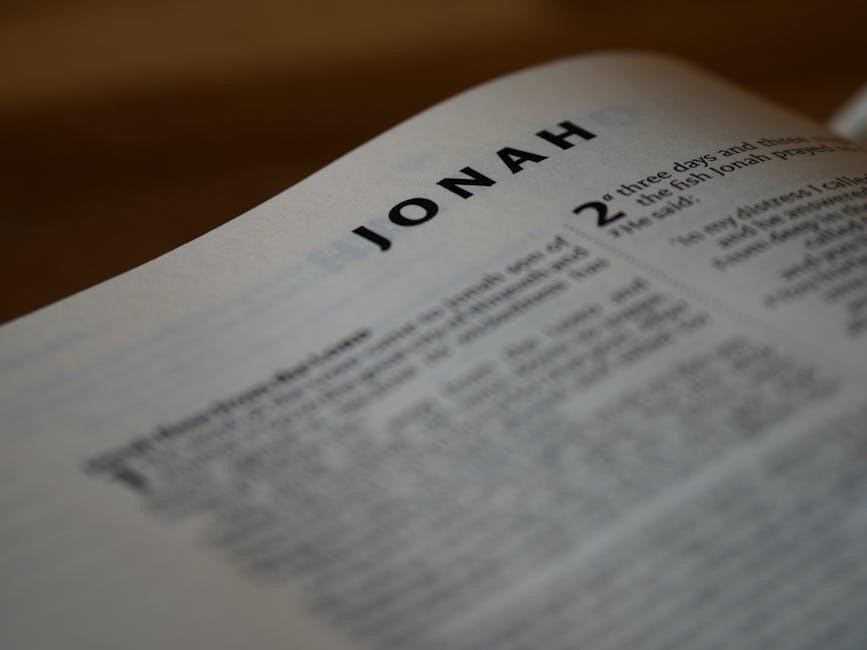
Exploring the rich journey of the Jewish people through a comprehensive timeline PDF reveals key events, cultural milestones, and historical significance. This visual guide spans thousands of years, offering insights into the development of Jewish identity, traditions, and resilience. It serves as an essential tool for understanding the interconnectedness of history, faith, and heritage, making it accessible for both scholars and newcomers. Interactive and educational resources complement the timeline, enhancing the learning experience.
Overview of Jewish History
Jewish history spans over 3,000 years, tracing the journey of a people bound by faith, culture, and shared experiences. From ancient origins in the Near East to global dispersion, the Jewish community has endured, adapting to diverse environments while preserving its identity. The timeline chronicles pivotal events, such as the Exodus from Egypt, the construction of the First and Second Temples, and the Talmudic era, which shaped Jewish law and tradition. The Middle Ages brought both flourishing cultural centers and persecution, while modern times saw the rise of Zionism and the establishment of Israel. Throughout, Jewish history reflects a resilient people navigating survival, intellectual growth, and the pursuit of freedom, leaving an indelible mark on global civilization.
Importance of a Timeline in Understanding Jewish History
A timeline is an essential tool for understanding Jewish history, as it provides a clear chronological framework for tracing the development of the Jewish people. By organizing events sequentially, a timeline helps to identify patterns, connections, and the progression of ideas and traditions. It allows learners to visualize how historical events, such as the Exodus, the destruction of the Temple, and the Diaspora, shaped Jewish identity and culture. A timeline also highlights the resilience and adaptability of the Jewish community, offering context for how they navigated challenges and celebrations across millennia. This structured approach makes complex history accessible, fostering a deeper appreciation for the richness and continuity of Jewish heritage.
Structure of the Jewish History Timeline PDF
The Jewish History Timeline PDF is structured to provide a clear and organized overview of major events and periods. It is typically divided into eras, such as Ancient, Middle Ages, Early Modern, and Modern, with key events highlighted. The timeline often includes concise descriptions, dates, and visual elements like boxes or lines to connect events chronologically. Color-coded sections or symbols may differentiate between political, religious, and cultural milestones. Sidebars or annotations offer additional context, while parallel timelines for world history provide a broader perspective. This format ensures readability and accessibility, making it easier to follow the progression of Jewish history and its cultural significance. The PDF’s layout balances detail with simplicity, enhancing educational and research purposes.
Ancient History of the Jewish People
The ancient history of the Jewish people begins with biblical figures like Adam and Noah, followed by the Patriarchs Abraham, Isaac, and Jacob. The Exodus from Egypt and the revelation of the Torah at Sinai are central events. The period also includes the establishment of the kingdoms of Israel and Judah, shaping the early Jewish nation and its religious foundations. This era laid the groundwork for Jewish identity, culture, and faith, influencing future generations. Key events are detailed in the timeline, highlighting their significance in forming the Jewish people’s heritage.
Creation and Early Biblical Figures (Adam, Noah)
The Jewish history timeline begins with the creation of Adam, the first human, and the story of Eden, marking the origin of humanity. Adam’s descendants include Noah, a righteous figure who obeyed God’s command to build an ark, saving his family and two of every animal from the Flood. This event symbolizes divine judgment and mercy. Both Adam and Noah are foundational figures in Jewish tradition, representing humanity’s relationship with God. Their stories, detailed in Genesis, establish moral and theological frameworks central to Jewish identity and worldview. These narratives are essential for understanding the origins of Jewish faith and culture, as highlighted in the timeline.
Abraham, Isaac, and Jacob: The Patriarchs
Abraham, Isaac, and Jacob are the foundational fathers of the Jewish people, central to the Jewish history timeline. Abraham, the first Patriarch, is celebrated for his unwavering faith and the covenant with God, symbolized by circumcision. Isaac, the son of promise, represents loyalty and trust in divine plans, as seen in the Binding of Isaac. Jacob, later named Israel, embodies resilience and spiritual growth, culminating in the naming of the Israelites. Their lives, detailed in Genesis, establish the covenantal relationship between God and the Jewish people, shaping Jewish identity and tradition. Their stories highlight themes of faith, family, and divine promise, forming the bedrock of Jewish heritage and history.
The Exodus from Egypt and the Giving of the Torah
The Exodus from Egypt marks a pivotal moment in Jewish history, as the Israelites escaped centuries of slavery under Pharaoh. Led by Moses, the Exodus was preceded by the Ten Plagues, culminating in the miraculous parting of the Red Sea. This event symbolizes liberation and divine intervention. Shortly after, at Mount Sinai, God revealed the Torah to the Israelites, establishing the foundation of Jewish law, ethics, and identity. The Torah includes the Ten Commandments and other teachings that guide Jewish life. This dual event—liberation and revelation—shapes Jewish theology, emphasizing freedom, covenant, and the divine mission of the Jewish people. It remains central to Jewish heritage and identity.
The Kingdoms of Israel and Judah
The period of the Kingdoms of Israel and Judah followed the reign of King Solomon, with the kingdom dividing into two upon his death. The northern kingdom, Israel, had its capital in Samaria, while the southern kingdom, Judah, centered around Jerusalem. Both kingdoms experienced periods of prosperity and turmoil, with Israel falling to the Assyrians in 722 BCE and Judah enduring until its conquest by Babylon in 586 BCE. Key events include the destruction of the First Temple in Jerusalem and the Babylonian exile. These kingdoms played a central role in shaping Jewish identity, culture, and religious practices, leaving a lasting legacy in Jewish history and tradition. Their stories are deeply intertwined with the Hebrew Bible.

The Middle Ages in Jewish History
The Middle Ages saw Jewish communities thriving under Islamic and Christian rule, with scholars like Maimonides shaping thought, cultural achievements in Spain, and the Expulsion of 1492.

The Talmudic Period and the Rise of Rabbinic Judaism
The Talmudic Period, spanning approximately 200–500 CE, marked the compilation of the Talmud, a central text of Rabbinic Judaism. Following the destruction of the Second Temple in 70 CE, Jewish leaders shifted focus from priestly Temple worship to rabbinic scholarship. Key figures like Ravina and Ashi finalized the Talmud, blending legal debates, ethical teachings, and biblical interpretations. This era solidified Rabbinic Judaism as the dominant form of Jewish practice, emphasizing Torah study and communal leadership. The Talmud’s structure, including the Mishnah and Gemara, provided a framework for Jewish law and identity. Yeshivot (rabbinic academies) in Babylon and Israel flourished, fostering a legacy of scholarship that shaped Jewish life for centuries.
Medieval Jewish Communities in Europe and the Islamic World
During the Middle Ages, Jewish communities thrived in both Europe and the Islamic World. In Europe, Ashkenazi and Sephardic communities developed distinct traditions, with centers in France, Germany, and Spain. The Islamic World, particularly under Muslim rule in Spain, experienced a cultural and intellectual golden age. Jews contributed to philosophy, medicine, and science, producing luminaries like Maimonides. Despite periods of persecution, such as during the Crusades, Jewish communities maintained vibrant religious and cultural life. In Europe, the rise of ghettos and restrictive laws shaped Jewish identity, while in the Islamic World, Jews faced varying degrees of tolerance and integration. These communities laid the groundwork for future Jewish cultural and religious developments.
The Golden Age of Jewish Culture in Spain
The Golden Age of Jewish Culture in Spain, spanning the 8th to 12th centuries, was a period of unparalleled cultural and intellectual flourishing. Under Muslim and Christian rule, Jews excelled in philosophy, medicine, astronomy, and literature. Figures like Maimonides and Judah Halevi produced seminal works that shaped Jewish thought. Jewish scholars translated Greek and Arabic texts, preserving knowledge for future generations. This era saw the rise of Ladino and the development of distinctive Jewish art and architecture. The interfaith dialogue and collaboration during this time fostered a rich cultural synthesis. However, the decline of Muslim rule and the Reconquista marked the end of this golden era, leading to increased persecution and eventual expulsion;
The Expulsion from Spain and Its Impact
The expulsion of Jews from Spain in 1492, under the Catholic Monarchs Ferdinand and Isabella, marked a tragic end to the Golden Age. The Alhambra Decree forced approximately 165,000 to 400,000 Jews to leave, with many fleeing to Portugal, North Africa, Italy, and the Ottoman Empire. This event devastated Jewish communities, disrupting cultural and economic ties. The Ottoman Empire welcomed refugees, while others faced persecution or assimilation. The expulsion ended Jewish life in Spain, leading to a decline in its cultural vibrancy. It also scattered Sephardic Jews globally, shaping their identity and traditions. The trauma of expulsion remained a defining moment in Jewish history, symbolizing resilience amid adversity.

The Early Modern Period
The Early Modern Period saw significant cultural, social, and religious transformations for Jews, marked by shifting political landscapes and intellectual movements across Europe and beyond.

The Renaissance and Its Influence on Jewish Life
The Renaissance brought cultural and intellectual revival, impacting Jewish communities in Europe. Jewish scholars engaged with secular knowledge, contributing to fields like medicine, astronomy, and philosophy. This era saw increased interaction between Jews and non-Jews, fostering mutual exchange. However, despite these advancements, Jews still faced discrimination and restrictions. The Renaissance also spurred Hebrew printing, preserving Jewish texts and spreading knowledge. This period marked a turning point, blending traditional Jewish learning with broader intellectual trends, laying groundwork for future Jewish Enlightenment movements. The intersection of Jewish and Renaissance thought highlighted the community’s resilience and adaptability amidst changing societal dynamics.
The Sabbatean Movement and Its Aftermath
The Sabbatean Movement, emerging in the 17th century, was a messianic movement led by Sabbatai Zevi, who claimed to be the Messiah. His followers, spread across Europe and the Ottoman Empire, believed in his divine mission to redeem Judaism. However, Zevi’s conversion to Islam under Ottoman pressure led to widespread disillusionment. Despite this, Sabbatean ideas persisted, influencing later Jewish mystical movements. The movement’s aftermath created a theological crisis, challenging traditional messianic beliefs. It also spurred debates about faith, redemption, and the role of charisma in religious leadership. The Sabbatean Movement remains a significant, if controversial, chapter in Jewish history, reflecting the tensions between mystical hope and communal reality.
The Rise of Hasidism and Haskalah
The 18th century saw the rise of two influential movements: Hasidism and Haskalah. Hasidism, founded by Rabbi Israel Ba’al Shem Tov, emphasized joy, mysticism, and a personal connection to God. It spread rapidly in Eastern Europe, focusing on emotional prayer and communal gatherings. In contrast, Haskalah, the Jewish Enlightenment, emerged as a response to modernization, advocating for secular education, rationalism, and integration into broader society. These movements reflected divergent responses to the challenges of modernity, shaping Jewish identity in profound ways. While Hasidism strengthened mystical traditions, Haskalah pushed for cultural and intellectual renewal, leaving lasting impacts on Jewish thought and practice.

19th and 20th Century Developments
The 19th and 20th centuries marked significant transformations for Jewish communities, including emancipation, Zionism, the Holocaust, and the establishment of the State of Israel, reshaping Jewish identity globally.
The Emancipation and Integration into European Societies
The 19th century saw the rise of the Jewish Emancipation, a movement advocating for the removal of legal and social barriers restricting Jewish life in Europe. Inspired by the Enlightenment and revolutionary ideals, nations like France, Germany, and Austria gradually granted Jews citizenship and equality. This period marked a shift from ghettoization to integration, enabling Jews to participate fully in political, economic, and cultural spheres. However, integration was uneven, with lingering prejudices and periodic anti-Semitic resurgence. Despite challenges, this era fostered Jewish contributions to European society, reshaping Jewish identity and laying the groundwork for modern Jewish life.
Zionism and the Movement for a Jewish Homeland
Zionism emerged in the late 19th century as a response to anti-Semitism and the desire for Jewish self-determination. Led by figures like Theodor Herzl, the movement sought to re-establish a Jewish homeland in Palestine, then under Ottoman rule. Herzl’s 1896 book, The Jewish State, became the manifesto for Zionism, advocating for a sovereign Jewish state to address persecution and assimilation. The First Zionist Congress in 1897 formalized the movement, leading to the creation of the World Zionist Organization. Despite opposition from both Arabs and assimilated Jews, Zionism gained momentum, culminating in the 1917 Balfour Declaration, which endorsed a Jewish homeland. This laid the groundwork for the eventual establishment of the State of Israel in 1948, fulfilling Zionism’s central goal.
The Holocaust: A Tragic Chapter in Jewish History
The Holocaust, occurring during World War II (1939–1945), was a systematic persecution and extermination of six million Jews by the Nazi regime and its collaborators. This dark period marked the deadliest genocide in human history, driven by antisemitic ideology. Key events included the Nuremberg Laws, Kristallnacht, and the “Final Solution,” which aimed to eradicate Jews through concentration camps like Auschwitz. The Holocaust also targeted other groups but disproportionately affected Jews, devastating communities globally. Its impact reshaped Jewish identity, leading to a renewed focus on survival and remembrance. The Holocaust serves as a stark reminder of humanity’s capacity for evil and the importance of combating hatred and prejudice.

The Modern State of Israel
Since its establishment in 1948, Israel has become a global hub for innovation, technology, and culture, shaping Jewish identity and resilience in the modern era.
The Establishment of the State of Israel in 1948
The establishment of the State of Israel in 1948 marked a pivotal moment in Jewish history, fulfilling Zionist aspirations for a Jewish homeland. On May 14, 1948, David Ben-Gurion declared independence, ending the British Mandate for Palestine. The 1947 UN Partition Plan had proposed separate Jewish and Arab states, but Arab nations rejected it, leading to the 1948 Arab-Israeli War. Despite being outgunned, Israel secured its sovereignty, with international recognition following. The new state absorbed waves of Jewish immigrants, including Holocaust survivors and refugees from Arab countries, shaping its diverse identity. This event revitalized Jewish self-determination and remains central to modern Israeli identity and global Jewish consciousness.
Wars and Conflicts: 1948 to the Present
Since its establishment in 1948, Israel has been engaged in numerous wars and conflicts, shaping its history and regional dynamics. The 1948 Arab-Israeli War marked its birth, followed by the 1956 Suez Crisis, where Israel, Britain, and France clashed with Egypt. The 1967 Six-Day War expanded Israeli territories, while the 1973 Yom Kippur War tested its resilience. The 1993 Oslo Accords aimed at peace but faced challenges. Recent conflicts include the 2006 Lebanon War and ongoing tensions with Hamas in Gaza. These events highlight Israel’s complex security landscape and the enduring quest for peace in the region.
Contemporary Issues and Challenges
In the modern era, the Jewish community faces diverse challenges, including the ongoing Israeli-Palestinian conflict, which shapes global perceptions and regional stability. Issues of identity, such as assimilation and the rise of anti-Semitism, particularly in Europe and online, remain pressing concerns. Israel grapples with political polarization and debates over the balance between religious and secular life. Diaspora communities navigate questions of Jewish continuity and engagement, while the legacy of the Holocaust continues to influence collective memory and education. Efforts to preserve Jewish heritage and address these challenges are supported by educational initiatives, cultural programs, and advocacy organizations worldwide.

Educational Resources and Tools
Jewish History Timeline PDFs offer a comprehensive overview of Jewish civilization, from ancient times to the modern era.
- These PDF resources are widely available online, providing detailed historical events and cultural milestones.
- They serve as educational tools for students, researchers, and enthusiasts seeking to understand Jewish heritage.
- Many timelines include visual aids like charts and maps to enhance learning and retention.
Jewish History Timeline PDFs: Sources and Availability
Jewish history timeline PDFs are widely available from reputable sources, including academic institutions, cultural organizations, and online archives. Many universities and Jewish studies departments offer free downloadable timelines as educational resources. Organizations like Yad Vashem, the Jewish Museum, and the Israeli Ministry of Education provide comprehensive PDFs covering key events from ancient times to the modern era. Additionally, platforms like Google Scholar and JSTOR host scholarly articles with embedded timelines. These PDFs often include detailed notes, images, and charts, making them invaluable for researchers and students. They are easily accessible online, ensuring that anyone interested in Jewish history can explore this rich and complex heritage.
Interactive Timelines and Digital Tools for Learning
Interactive timelines and digital tools have revolutionized the way Jewish history is studied and taught. These resources provide engaging and immersive experiences, allowing learners to explore historical events in depth. Platforms like Timeline JS and Chronas enable users to create customizable timelines, embedding images, videos, and primary sources. Digital museums, such as the YIVO Institute and The Jewish Museum, offer virtual exhibitions that bring history to life. Mobile apps like Jewish History Timeline and Sefaria provide accessible learning on the go. These tools also include features like zooming, clickable events, and multimedia content, making Jewish history accessible and engaging for all ages and educational levels.
- Digital tools enhance retention and understanding through interactivity.
- Virtual platforms allow global access to historical resources.
- Interactive timelines foster a deeper connection to Jewish heritage.
Such innovations ensure that Jewish history remains dynamic and relevant in the digital age.
Books and Courses on Jewish History
Exploring Jewish history through books and courses provides a deeper understanding of its rich and complex heritage. Classic texts like the Hebrew Bible and the Talmud offer foundational insights, while modern works by historians such as Simon Schama and Yosef Hayim Yerushalmi provide comprehensive narratives. Academic courses from institutions like Hebrew University and online platforms such as Coursera and edX allow learners to engage with structured curricula. Additionally, documentaries and podcasts like The Story of the Jews and Jewish History Matters make the subject accessible to a broader audience. These resources are invaluable for scholars and enthusiasts alike, fostering a nuanced appreciation of Jewish history and its global impact.

Cultural and Historical Significance
The Jewish history timeline PDF highlights the cultural and historical significance of Jewish heritage, showcasing its profound impact on global traditions, identity, and contributions to human civilization.
The Role of Tradition and Heritage in Jewish Identity
Tradition and heritage are cornerstone elements of Jewish identity, serving as a bridge between past and present. Jewish customs, such as Shabbat observance, dietary laws, and holiday celebrations, have been meticulously preserved and passed down through generations. These practices not only provide a sense of continuity but also foster a strong communal bond. The study of Torah and Talmud, alongside the transmission of Hebrew language and liturgy, further enriches Jewish heritage. These traditions have played a pivotal role in sustaining Jewish identity, especially during periods of exile and persecution. By honoring their heritage, Jews connect with their ancestors and reaffirm their commitment to a shared history and culture.
Key Figures in Jewish History and Their Contributions

Throughout Jewish history, numerous influential figures have shaped the trajectory of the Jewish people. Abraham is revered as the patriarch who established the covenant with God, while Moses led the Exodus from Egypt and received the Torah. King David founded Jerusalem as the capital, and his son Solomon built the First Temple. In the Talmudic era, Hillel the Elder emphasized compassion and inclusivity, laying the foundation for rabbinic Judaism. Medieval scholars like Maimonides and Rashi provided enduring interpretations of Jewish law and texts. Later, Isaac Luria influenced Kabbalah, while modern figures like Theodor Herzl and Golda Meir played pivotal roles in Zionism and Israel’s establishment.